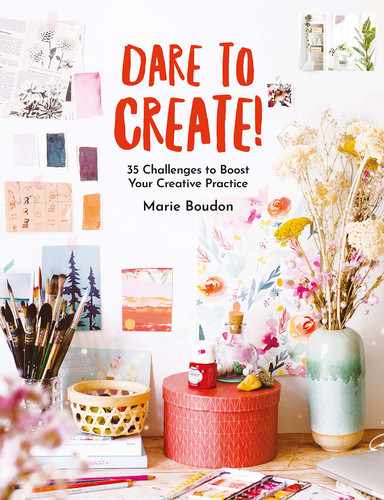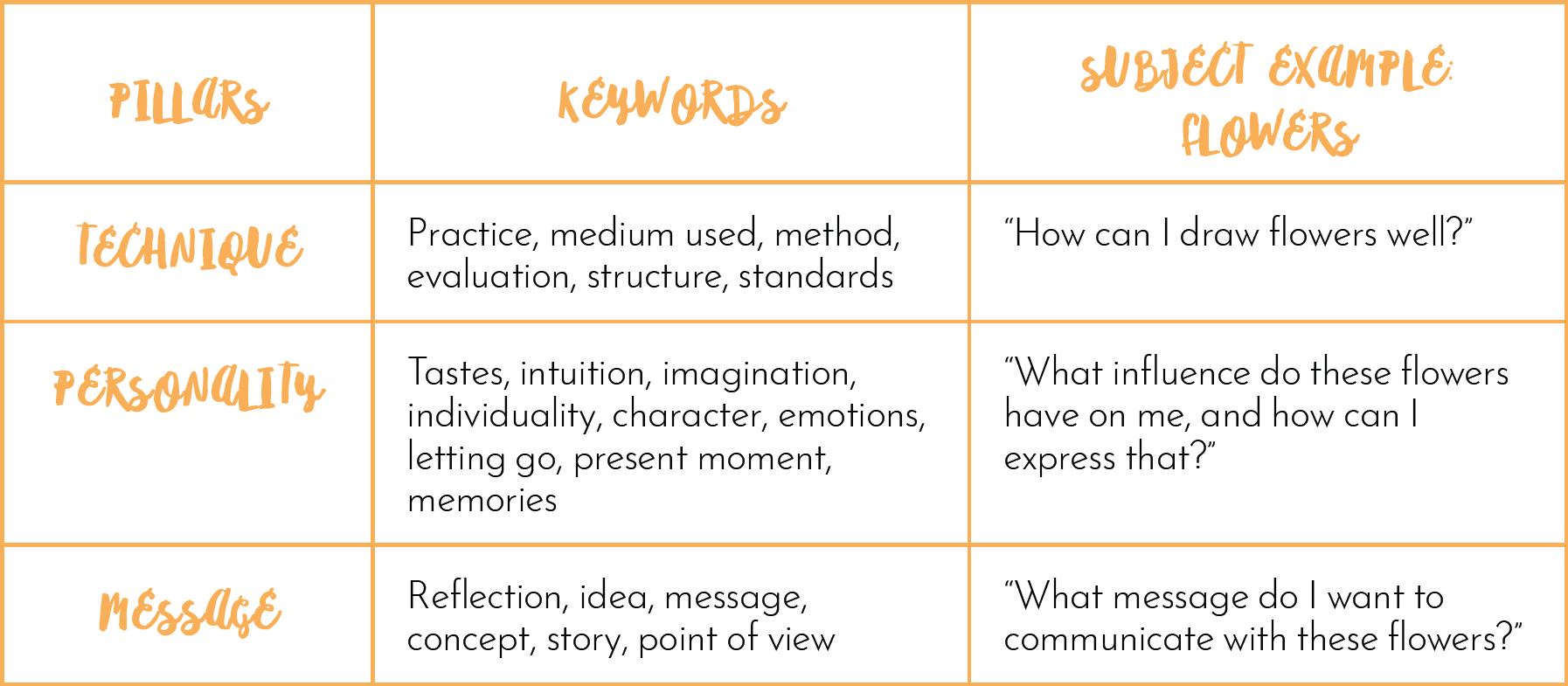 CHALLENGE 30
CHALLENGE 30 
Nurturing your sensitivity
AFTER PAINTING IN WATERCOLOR FOR A FEW MONTHS, I STARTED FEELING THAT MY PAINTINGS WERE LACKING A SOUL. I ASKED MYSELF: WHAT DOES A CREATION DEPEND ON BESIDES TECHNIQUE? HOW CAN I MAKE IT RICHER? IN THIS CHALLENGE, I OFFER YOU MY REFLECTION ON THIS. MY CONCLUSION IS THAT A CREATION DEPENDS ON THREE PILLARS: TECHNIQUE, PERSONALITY, AND MESSAGE, COMBINED IN DIFFERENT WAYS DEPENDING ON THE SENSITIVITY OF THE ARTIST. THIS CHALLENGE WILL ALLOW YOU TO EVALUATE YOUR SENSITIVITY AT A GIVEN TIME AND TO ASK YOURSELF WHAT DIRECTION YOU WOULD LIKE TO GO IN.
Three creative pillars
In analyzing the work of multiple artists, I was able to discern three pillars that could be used to describe an artistic creation: technique, personality, and message. This personal analysis is necessarily subjective. You may see things differently.
The way in which these pillars are combined (with a focus on just one of them, or a balance of the three, etc.) is independent of the artistic style and the subject being represented.
Creative pillars, keywords, and examples
Pillar 1 - Technique
The first pillar that a beginner works on is often technique. This allows you to obtain a solid foundation, which is essential to gaining confidence. Pursuing technical excellence is not a bad thing. However, if the only interesting thing about what you’ve made is its perfect execution, isn’t it a little empty and soulless? How will you distinguish yourself from any other artist who uses the same technique as perfectly as you do? Is there any way to differentiate between two photographers who immortalize the same scene using the exact same technique, or do they become interchangeable? I believe that they will indeed be interchangeable unless they add a little bit of personality or a message in their art (pillars 2 and 3).
Pillar 2 - Personality
Are you more calm, an observer, enthusiastic, an extravert, serious, funny, or tending to anger? These aspects of your personality can emerge in your art, through your movements (as in dance or painting) or through your energy. The way that you invest yourself in your art can completely change the feelings induced in those who see or hear your work. Imagine a dance that is perfectly executed but without any personal expression: it’s a perfect series of movements from a technical point of view, but is it interesting? It is not necessarily easy to express your personality in your art. It requires you to be connected with your own emotions and feelings. To help make that happen, see challenges 19, 26, and 27.
Pillar 3 - Message
The third pillar is the one that has made me think the most. Why do I create? Is my art sending a message or telling a story? No, my art is mostly decorative and ornamental; my goal, above all, is for it to please me esthetically. Is that a problem? I have come to the conclusion that it is not. You don’t have to use the pillar of the message in your art if you don’t want to. It’s up to you to decide where you come down on this question. However, in order to make your art evolve, it is inspiring to study the point of view of other artists who do use this pillar.
What kinds of message should you express in your work?
There are many different subjects, and they often don’t have a physical representation.
You could:
![]() illustrate a point of view, a reflection, or a debate on a political, social, cultural, environmental, spiritual, etc. subject.
illustrate a point of view, a reflection, or a debate on a political, social, cultural, environmental, spiritual, etc. subject.
![]() tell a story or share an experience.
tell a story or share an experience.
![]() present a concept or an idea.
present a concept or an idea.
Starting in the 1960s, some artists focused their art on the idea that it was transmitting rather than on its presentation, calling this conceptual art. In other words, they almost only used the third pillar in their expression. They abandoned visual experience in favor of reflection. In her thesis (“Conceptual art, psychoanalysis, and the paradoxes of language: a dialogue between Joseph Kosuth and Sigmund Freud,” 2017), Fernanda Pereira Medina explains it this way: “Simply put, the basic idea of conceptual art is the idea that artists are working with meaning rather than with form, color, or material.” Joseph Kosuth is one of the major figures of conceptual art.
Food for thought:
BELIEFS • CULTURE • DEATH DESTINY • DIFFICULTIES • DREAMS ENVIRONMENT • EXCESS • FAMILY FEAR • FREEDOM • FRIENDSHIP FUTURE • HAPPINESS • INTOLERANCE JUSTICE • KNOWLEDGE • LOVE MADNESS • MEMORY • NOSTALGIA POLITICS • RELIGION • REVOLTS SCIENCE • SOCIAL MOVEMENTS • SOCIETY SOLITUDE • SPIRITUALITY • SUFFERING TIME • TRADITIONS • WAR • YOUTH . . .
Telling a story
Even if you don’t go as far as using only the third pillar, it can still be interesting to include it in your art. The simplest way to begin this exercise is to tell a story. The Swedish painter and illustrator Camilla Engman explained to the website Fast Company in 2015: “The human brain seems to want to understand things. If you put two things together, it immediately starts to think about why and what. For me, that makes up a story.”
In a discussion with Youngman Brown for the podcast Your Creative Push, Alex Strohl, a French adventure photographer based in the United States, claimed that telling a story is more important than technique. “We all have a unique story to tell. If you spend time working on what makes you different—and only that—I think that you will push your art to a new level. . . . If it has life in it, if the reason why you took the photograph shines through, then it doesn’t much matter whether it’s overexposed, underexposed, or blurry. It may be a cliché, but I think that the goal is to concentrate on the story that needs to be told.”
Sunny backyard, watercolor and colored pencil on paper, 2017.
Through her drawings, Ira transmits her vision of the world. The realism of a particular scene is not what interests her the most; she freely mixes the real and the imaginary.
Don’t beat yourself up if your art is just decorative, or if, on the other hand, it is too political or conceptual. Just try to follow your own curiosity (challenge 10) and be authentic (challenge 31). It is up to you to decide how you want to implement the three pillars in your practice. Telling stories and sharing ideas with your art is not absolutely necessary, and it requires time and confidence.
City park, watercolor and colored pencil on paper, 2016.
Ira’s illustrations immerse the spectator in a poetic story and universe (see her story on page 64).
Spotlight on Carrie Shyrock
The American painter Carrie Shryock shared this reflection on her Instagram page: “The other day, I heard someone saying, ‘If the subject of your art is only what it represents, then it probably isn’t art.’ I’m not sure if I agree, but it made me think. Recently, I’ve been trying to understand the meaning of all of these landscapes and skies that I paint. I ask myself what shape they should take, how they should evolve. I know that I really like large open spaces because of my childhood on the Missouri prairie. That’s part of me. I like feeling very small in a huge, magnificent landscape. I was in New York these last few weeks and I felt the same feeling there, but in a very different way. I think about that a lot. That same person also said, ‘Art is when you take the thing that is most important to you and give it a shape. That’s a challenge. That should be a challenge.’ Yes, I approve.”
![]() Your Turn
Your Turn ![]()
- 1. Analyze your work. Which of the three pillars (technique, personality, message) do you use the most often?
- 2. Are there certain pillars that you use less? With the help of the suggestions in this challenge, think about ways you could experiment with them more.
- 3. Based on these reflections, start an art piece that draws on the pillars that you use less frequently.






